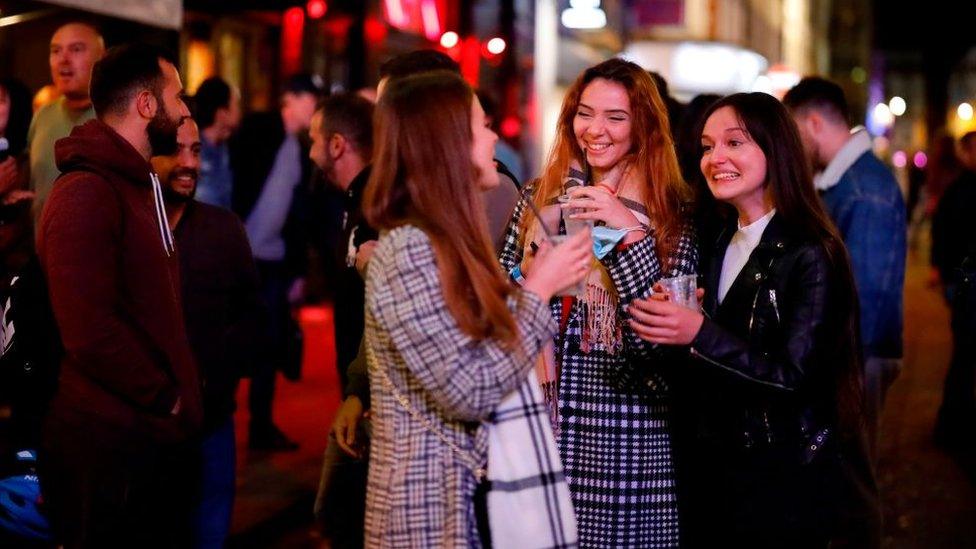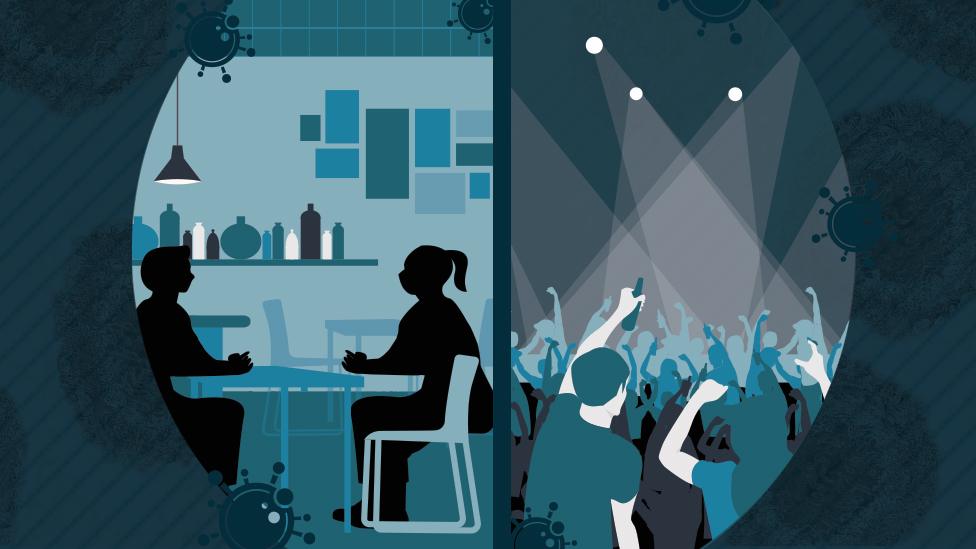Covid rules: What's the evidence for pub restrictions and curfews?
- Published

Pubs in England will still face restrictions when the national lockdown ends on 2 December and a new, tougher system of tiers is introduced to try to tackle the spread of coronavirus.
The government has also said it will loosen its 10pm curfew for pubs.
So, why are pubs facing these controls and what is the evidence for them?
What are the new rules for pubs?
It depends which tier the local area is put in:
Tier 1 - pubs can open but venues must be table service only, with last orders at 10pm
Tier 2 - pubs can only serve alcohol if it is with a "substantial meal"
Tier 3 - all hospitality (including pubs) must close (apart from takeaway and delivery options)
The restrictions in Tier 2 will affect so-called "wet pubs" which don't serve substantial meals.
The British Beer and Pub Association says they account for two thirds of pubs in England - that's about 25,000.
There are different rules in other nations in the UK.
In Scotland's tier system, pubs and restaurants are closed in level 4 and prevented from selling alcohol and required to close at 6pm, in level 3.
In Wales, pubs have to stop selling alcohol at 10pm but groups of four people from different households are allowed to meet indoors.
And in Northern Ireland, from 27 November, pubs (and bars and restaurants) can only offer takeaway, drive-through or delivery.
There is support available from the government. For example, businesses that are forced to close in England can receive up to £3,000 for each 28 day period. Those which have not been required to close but have been severely affected by restrictions may receive grants worth up to £2,100 for each 28 day period.
In Scotland, external it's between £2,000 or £3,000 for those forced to close and £1,400 or £2,100 for those affected by restrictions, depending on the rateable value of the property. That's also every four weeks.
Why are there restrictions on pubs?
Indoor venues, including pubs, bars and restaurants, have long been considered particularly vulnerable to the spreading of Covid-19.
"Wherever you get people crowded together, for example concert halls, cruise ships, house parties, bars and pubs, you risk spreading a virus," says Dr Julian Tang, a professor in respiratory sciences at the University of Leicester.
If people are sitting near each other talking without face masks or coverings, it can maximise the amount of spit droplets that are transferred between people, he says.
His research also highlights the potential risk if the virus, external is projected into the air whilst breathing and talking, where it stays suspended and may then be inhaled by others.

The World Health Organization has acknowledged that there is emerging evidence that coronavirus can be spread by tiny particles staying in the air and "more studies are urgently needed."
Evidence from the Scientific Advisory Group for Emergencies (Sage, external), which reports to the government, highlighted venues serving alcohol as a significant risk.
"Smaller gatherings such as bars and nightclubs are higher risk as you can be in closer contact with others," a report from the 11 February warned.
The new measures are aimed at further reducing the overall period of time that people spend in close contact with each other in pubs and restaurants.
What about the "substantial meal" rule?
We can't find a lot of specific scientific evidence supporting this rule but the logic seems to be based on the impact drinking can have on behaviour.
The Scottish government has published an impact assessment , externalof it.
It says clinicians believe consuming alcohol limits people's ability to follow coronavirus rules.
It says combining drinking with a main meal cuts the effect of the alcohol as well as reducing the volume and speed of consumption.
What about the curfew rule?
A Sage report, external from September said "Curfews [are] likely to have a marginal impact", although it said it only had "low confidence" in that conclusion, suggesting there has been limited research into the question.

Previously, we asked the Department of Health and Social Care (DHSC) if there was any specific scientific advice about the cut-off time for pubs, bars and restaurants.
It did not provide it but said: "The 10pm closure allows people to continue to socialise while reducing the risk of failing to socially distance."
The government is now changing the curfew in England to allow for last orders at 10pm and closing at 11pm, external.
It says this will allow customers to "depart gradually" (when the original curfew was introduced there were scenes of pub-goers all leaving at once and crowding onto public transport).
Has the virus been spread in pubs and restaurants?
We have some data but it does not tell the full story.
Public Health England (PHE) releases figures on outbreaks, external of coronavirus by the type of institution.
A total of 3,154 Covid-19 outbreaks were recorded between 3 August and 4 October (we're using this data because it corresponds with a period when pubs were open), including:
171 outbreaks (5.4%) in restaurants or food outlets
835 outbreaks (26.4%) in educational facilities
933 outbreaks (29.6%) in care homes
661 outbreaks (21.0%) in workplaces
But this data requires two or more cases to be tracked down to the location via PHE's Health Protection Teams.

This means these people must get tested, report accurately where they had been to the government's Track and Trace programme, and for an investigation to conclude that these places had been the source of outbreaks.
This might be easier to do with closely monitored or prioritised places like schools, hospitals and care homes.
The Test and Trace system attempts to find out the places people visited in the week prior to showing coronavirus symptoms.
Of the 87,128 events people said they had attended in which there was some contact with others between 10 August and 24 September:
12,734 were eating out
11,700 shopping trips
about 6,000 holiday trips
just under 5,000 school visits
This data only highlights where people went prior to getting the virus but this may not be where they actually caught it.
Public Health England does say it is helpful in indicating "possible places where transmission is happening".

THE R NUMBER: What it means and why it matters
SOCIAL DISTANCING: What are the rules now?
LOOK-UP TOOL: How many cases in your area?
SOCIAL LIFE: Is it safe to go to the pub?


- Published14 July 2021
